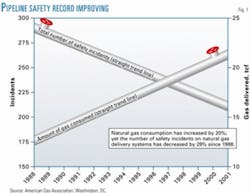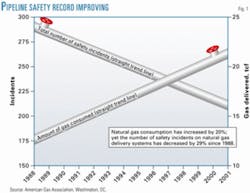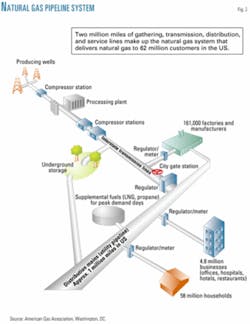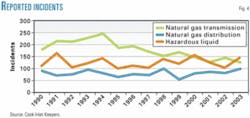Pipeline safety successes, challenges detailed to Congress
The US Department of Transportation Inspector General recently told two congressional committees that the Office of Pipeline Safety is making considerable progress meeting legislative mandates set in 1992, 1996, and 2002.
OPS is also following recommendations made by the National Transportation Safety Board, a huge improvement over 5 years ago, the IG said June 15.
But the DOT watchdog cautioned OPS' job is not done yet; regulators and industry cannot become complacent.
The OPS requires pipeline companies to develop and implement integrity management plans, which are used to measure the risk of a leak or failure in a system. Pipeline operators also must take action to mitigate risks and develop program-performance measures.
But only a small percentage of the pipeline network has been inspected and the inspection process won't be complete for several years, the IG said.
"While OPS has made progress in implementing the recommendations, the work is not done. The current situation is far from an 'end state' for ensuring the safety of the nation's pipeline system," the IG told lawmakers.
The General Accounting Office plans to release its own report on OPS enforcement in late July.
Distribution pipeline rules
The IG's report to Congress recommends that OPS require operators of natural gas distribution pipelines to implement an enhanced safety program similar to those used by hazardous liquid and natural gas transmission lines.
Two years ago Congress required operators of natural gas transmission pipelines to develop and implement integrity management plans but did not require the same for natural gas distribution pipelines.
"We are concerned that the 1.8 million miles of natural gas distribution lines (which deliver gas to businesses and consumers) don't have to undergo safety inspections, even though they have the worst safety record of all pipelines.
"OPS needs to move quickly on this issue. Over the last 10 years, natural gas distribution pipelines have experienced over 4 times the number of fatalities (174) and more than 3.5 times the number of injuries (662) than the combined totals of 43 fatalities and 178 injuries for hazardous liquid and natural gas transmission pipelines," the IG said.
The IG also urged the agency to complete its web-based system for monitoring the cost, schedule, and performance of research and development projects and finalize and implement best practices for its internal review process.
With regard to security issues, OPS should petition DOT to formalize its security responsibilities, the IG said.
OPS agreed in general with the recommendations; officials said they are working to address all the issues cited in the IG's draft and cooperating with GAO on its pending study.
Industry response
Industry representatives from gas utilities, as well as oil and gas pipelines told congressional committees they have a good story to tell on pipeline safety.
"Delivery of energy by pipeline is consistently the safest mode of energy transportation," Atmos Energy Corp.'s Senior Vice-President of Utility Operations Earl Fischer said, speaking for the American Gas Association and the American Public Gas Association.
"Over the last 17 years, the amount of natural gas traveling through distribution pipelines has increased by about a third and more than 650,000 miles of pipeline have been added to the system—yet the number of reportable incidents on distribution lines has decreased by 25%" (Figs. 1 and 2).
Fischer and other trade groups called on OPS to continue working toward a faster permit repair and maintenance process that includes other federal agencies.
The Interstate Natural Gas Association of America warned that unintentional natural gas price spikes might occur unless inspection schedules are revised to allow competing pipelines to coordinate turnarounds.
Anti-trust laws currently restrict such an action, but Congress could issue a special waiver, the group said.
"In the absence of such coordination, however, it is possible and even likely that multiple pipelines serving a given market could be down for inspection/repair at the same time, causing significant price increases and even service disruptions for that market," said Robert Howard of Gas Transmission Northwest Corp.
Speaking on behalf of the Association of Oil Pipelines and the American Petroleum Institute, Barry Pearl, president and chief executive officer of TEPPCO Partners LLC, said the Pipeline Safety Improvement Act of 2002 encourages collaboration between industry and regulators, and the law's success has come without "threat of punishment or the need for financial incentives."
He added: "the program aligns the interests of the operator and the regulator—to adopt the most effective and efficient preventative measures to keep the oil in the pipe. The recent spill and accident record of the pipeline industry only underlines this success. Put simply, our industry's substantial investment in pipeline integrity and leak prevention is a sound one, providing long-term benefits to both pipeline operators and the public (Fig. 3)."
Other views
Lois Epstein, senior engineer, oil and gas industry specialist for the Anchorage, Alas.-based environmental group Cook Inlet Keeper, said OPS is definitely moving in the right direction with regard to safety issues, but it still needs to show it is serious about preventing accidents.
She suggested that OPS initiate several high-profile, preventive enforcement actions to deter potential violators.
"Currently, OPS only pursues high-profile enforcement actions following pipeline accidents.
"Preventive enforcement, in contrast, would require OPS to penalize pipeline companies whose operations might result in serious releases prior to a release occurring.
"Major civil enforcement actions identifying violations of standards prior to accidents should be publicized and readily available on OPS' website. Without a preventive approach to enforcement, it's practically pointless to have preventive requirements in place.
"Thus, the committee needs to ensure that OPS commits to enforce violations of its regulations, both prior to and following accidents (Fig. 4)."
Keep OPS in DOT
Both trade and environmental groups warned that a pending plan to move OPS from DOT to the Federal Railroad Administration could derail the agency's progress over the past 5 years in meeting administration and legislative pipeline rules.
They argue that a move would make the agency's budget less secure; moreover, the reorganization itself would be a distracting force at a time when OPS must meet critical pipeline inspection deadlines.
Cook Inlet's Epstein, for example, warned that OPS could face new budget constraints as it plays a role in the LNG permitting process. The 2002 law, she said, contains language dating from 1968 and 1979 that describes OPS' role in regulating LNG facilities.
"While much recent attention has been focused on the Federal Energy Regulatory Commission's role in siting LNG import-regasification facilities, little attention has been paid to OPS' role in developing, implementing, and enforcing LNG siting, operating, and contingency plan rules.
"The reason this issue is important to the committee is that the committee is aware of OPS' currently constrained inspection and enforcement resources. Given these resource constraints and the likelihood that OPS will need to initiate some new LNG-related rulemaking, policy, and enforcement work with the expected expansion of new LNG facilities in the US, OPS soon might face severe resource challenges. Without additional OPS resources, safety concerns for LNG and/or pipeline facilities nationwide might result. "
The five trade groups that represent oil and gas pipelines recently endorsed a proposal by Rep. Don Young (R-Alas.), chairman of the House Transportation and Infrastructure Committee, to keep OPS within DOT. HR 4277, the Pipeline Safety Administration Establishment Act, would establish an independent pipeline safety administration within DOT.
Similarly, Young's Senate counterpart, Sen. John McCain (R-Ariz.), on June 17 wrote a letter to Sec. of Transportation Norman Mineta urging him to reconsider the DOT proposal to relocate the OPS office to FRA.
"Moving OPS to FRA could disrupt the momentum the agency has worked hard to develop," McCain wrote. "In fact, it appears the uncertainty of OPS' fate at the department may already be having an impact on morale and the agency's ability to recruit candidates to fill open positions."




